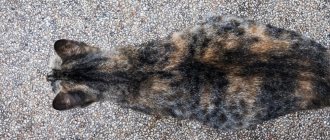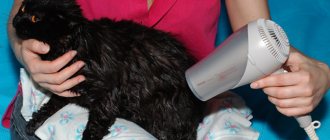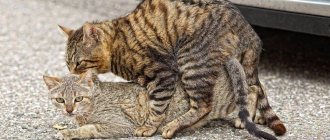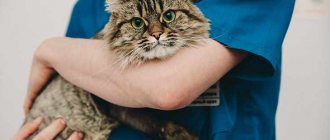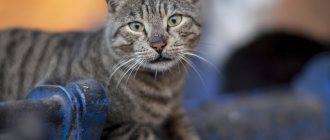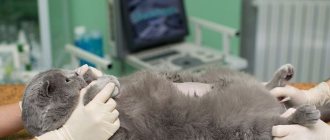Most pet owners do not buy them for breeding and producing offspring. They think about how to prevent pregnancy in females. However, sometimes unwanted matings occur. In order not to physically injure the animal, the owner gives it the opportunity to give birth to kittens, and then clearly decides to engage in sterilization in order to avoid accidental re-mating. When can a pet be sterilized after the birth of offspring? What do cat owners need to know about this procedure?
The ideal time to sterilize a cat
Sterilization is an operation to remove organs related to the reproductive system. In the future, the animal will no longer be able to become pregnant and bear offspring. Sterilization is carried out using two methods:
- only the ovaries are removed;
- The uterus and ovaries are completely removed.
In the first case, the cat will not be able to get pregnant, because... The production of sex hormones stops, and a change in hormonal levels occurs. The risk of tumors and cysts is reduced. This method is applicable to young and nulliparous animals with a healthy uterus. But after this operation, there is a high probability of purulent inflammatory processes in the uterus, the development of endometritis and other diseases.
In the second case, the cat’s uterus is removed along with the ovaries. The operation is performed as a planned procedure or for various indications (unsuccessful childbirth, uterine pathologies, etc.). This significantly reduces the risk of many health problems.
The ideal time for the procedure is the period when the pet is already ripe for sexual activity, but has never become pregnant.
There is a common myth that it is better to spay cats after giving birth. However, the birth of kittens leads to the production of sex hormones, which are responsible for sexual desire. Moreover, they will be produced not only by reproductive organs, but also by other organs. Constant stress puts a strain on the animal’s nervous system.
The operation is best performed 5-7 days after estrus. If this fails, then veterinarians carry out surgical intervention during the period of sexual hunting. However, the animal’s recovery is much more difficult.
Emergency cases
There are situations when an animal has to be operated on during pregnancy. This problem doesn't happen often.
Indications for sterilization when bearing offspring are:
- serious pathologies requiring immediate surgical intervention;
- high probability of death of the animal during childbirth;
- offspring unwanted by the owner;
- injuries and infectious diseases in a cat, due to which cubs may be born with defects.
Sometimes cats may need emergency sterilization
Serious and life-threatening pathologies that require surgical intervention even during pregnancy and in the first days after childbirth are:
- pyometra – inflammation of the uterus, accompanied by the accumulation of large amounts of pus;
- hematometra - accumulation of blood in the uterine cavity;
- hydrometer - filling the uterine cavity with liquid;
- endometritis – inflammation of the uterine mucosa.
There is no other treatment other than sterilization for the above diseases.
Can a cat be spayed immediately after giving birth?
You cannot subject your pet to surgery immediately after the birth of kittens, because the uterus has not yet reached normal size and hormonal levels have not been restored. During pregnancy, the uterus changes its shape and size and grows thick blood vessels, so any operation immediately after the birth of kittens can provoke severe bleeding. In addition, the uterus becomes less elastic, and it is more difficult for the doctor to apply a ligature. It can also cause bleeding.
Before giving birth, the animal's hormonal levels change to ensure regular contractions. When kittens are born, the cat’s body begins to rebuild and lactogenesis begins. If the doctor immediately removes the ovaries, which are the main endocrine glands, then the animal receives severe stress as a result of a lack or excess amount of sex hormones. This negatively affects the health of the pet. In addition, lactation stops, and the kittens will have nothing to eat.
Sometimes the uterus and appendages are removed from a cat immediately after birth for medical reasons. These include:
- uterine rupture;
- placental defects;
- atonic bleeding;
- pathologies of the ovaries and uterus that were discovered during pregnancy.
These indications can only be determined by a veterinarian. After surgery, the animal must be especially carefully cared for.
Complications
Complications can be expressed in the form of lethargy and drowsiness, enlarged mammary glands, hernia, lack of appetite, abnormal bowel movements, changes in body temperature, the appearance of a rash, bleeding of the suture, heavy breathing, accompanied by wheezing, pallor or redness of the mucous membrane. Typically, all these symptoms go away on their own within a day or two.
Before surgery, the cat is given an anesthetic drug of minimal toxicity that does not have a negative effect on the body. Despite this, anesthesia causes its own complications: blood pressure rises, metabolism slows down, the pulse may become irregular, and allergies may appear. The result can be heart failure or even anaphylactic shock.
When not to sterilize
If the offspring does not survive after birth, the cat cannot be sterilized immediately. According to the recommendations of veterinarians, it is necessary to wait at least 2 weeks. If an animal feeds kittens, then subjecting it to such a procedure is prohibited. After surgery, they can injure the mammary glands, which can subsequently lead to infection of the sutures. Therefore, it is advisable for the mother to feed the kittens, and then the uterus and ovaries can be removed.
In addition, during the procedure, the doctor may damage the milk ducts, causing milk production to stop. The process of natural feeding stops, and the owners begin to feed the kittens. This will require special food for newborns and special care for pets.
If the cat does not want to feed her offspring, then there is still no need to rush into surgical intervention. Such an operation is associated with risks to the health of the animal, including death. After sterilization, the pet ceases to be interested in her kittens, does not pay attention to them, and does not train them. She can also treat them with aggression, perceiving them as someone else’s cubs.
Contraindications
In some cases, sterilization is contraindicated. Causes:
- Allergy to certain medications.
- The disease and the period immediately after it.
- Recent injury.
- Individual intolerance to anesthesia.
In any case, the cat must first be examined by an experienced veterinarian and give an opinion. Additional examination may be required to identify other contraindications.
Castration is not recommended after 10 years of age, since the risk of postoperative complications is very high. The same applies if the cat is too young; surgery can slow down the development of the animal.
Is it worth subjecting your pet to this procedure?
As a result of sterilization, any behavior related to sex is limited or eliminated (for more information, read the optimal age for the operation). Kittens after her:
- They cause less trouble to their owners,
- They become quieter, since the procedure eliminates loud vocalizations,
- They rub less against human feet and furniture.
Like any surgical procedure, it is associated with certain risks and complications. They occur even during the use of anesthesia or during the operation itself, i.e.:
- Ruptures of the edges of the wound,
- Complications associated with healing
- Bleeding
- Infections.
Don't forget about the increased risk of obesity. This results from a decrease in metabolic rate, decreased physical activity, and increased appetite. Neutered cats are more likely to suffer from diabetes as a result of increased body weight in these individuals.
Preparing for surgery
- Choosing a clinic. A few weeks before the proposed procedure, you need to start looking for a good and reputable veterinarian. You need to understand that highly qualified and experienced specialists do not provide services cheaply.
- Diet. Both before the operation and during rehabilitation, the pet should follow a diet. If the cat eats natural food, then the diet should be based on boiled beef and poultry. If the animal is accustomed to dry food, then you need to buy premium food.
- Medical supplies. It is necessary to purchase a collar that will prevent the animal from licking and biting the operated area. You should also ask your veterinarian what medications to buy for treating postoperative sutures. Treatment is carried out within 10 days after the procedure. To prevent the cat from tearing the seams with its claws, many owners purchase a belly bandage.
- A place for rehabilitation. The recovery from anesthesia is individual for each animal: some cats regain consciousness a couple of hours after the operation, while others remain lethargic and drowsy all day. For comfortable rehabilitation, a cat needs to build a soft bed and place it in a quiet and shaded place. During the recovery period, the cat should not be pulled or shouted at.
- Painkillers. The animal will experience pain in the abdomen for several days. Therefore, it is impossible to do without anesthetics. Among human medicines, Papaverine, No-shpa, and Ketonal are suitable for animals. The dosage and therapeutic course are prescribed by the veterinarian. It is forbidden to choose painkillers for your pet at your own discretion, since many human medications are dangerous for cats.
Preparing a cat for sterilization
The happiness of motherhood
This kind of misconception can often be heard from inexperienced owners: “A cat needs to give birth at least once for health”, “The cat wants to experience the joy of motherhood”, “Giving birth is good for the animal’s body” - it’s not necessary, it doesn’t want, it’s not useful. All outbred animals and animals of no breeding value must be castrated.
INTERESTING! Everything new is well forgotten old. In the 1900s, sterilization of cats was carried out at an early age, until at one of the conferences the question was raised about the negative side effects of early (up to 7.5 months) castration. This theory has not received scientific substantiation, however, they stopped castrating animals before full puberty.
Regular empty estrus, pregnancy and childbirth weaken the cat’s body . According to veterinary statistics, the life expectancy of castrated animals is significantly higher than their loving relatives.
Veterinarian recommendations
Below are some recommendations based on the most frequently asked questions about this surgery.
- Before performing surgery, the age of the cat must be taken into account. Intervention performed too early or late entails many complications.
- Nursing cat mothers need to delay sterilization until the end of the lactation period. The body will fully recover in at least 2 weeks after the kittens are taken from their mother.
- If the cat does not feed the offspring, the operation cannot be performed earlier than a month after birth.
- A cat needs to give birth at least once before being spayed - a common misconception. This in no way affects the health of the pet or the operation. If you do not need kittens in the future, you need to sterilize at the earliest possible date.
- Before 4 weeks of pregnancy, it is quite possible to carry out sterilization, if necessary.
- Get tested and get the necessary vaccinations, they will help protect your pet from infection.
Rejection of suture material
Sometimes a cat's stitch may come apart after sterilization, even if she did not lick the wound. If non-sterile suture material was used during the operation, and the rules of asepsis and antisepsis were not followed, the wound may become infected.
Most often, a negative reaction occurs to non-absorbable threads (silk), too thick, coarse threads. Sometimes it is enough to remove the nodule from the wound for the reaction to stop.
If there are problems with the seam, owners notice that the cat's blanket gets wet. Or some stains or smudges appear on it. After sterilization, the seam should be clean and dry, and the skin in the wound area should be tightly closed joint to joint. If you see swelling, redness or discharge (usually this is not pus, but something like ichor) in the suture area, immediately show your pet to the surgeon. Treatment of the problem is the same as if a cat licked a seam.
Rarely, cats have a true reaction to suture material (rejection). In this case, you need to use threads made of a different material or even a special metal wire, which is removed after the tissue has healed.
